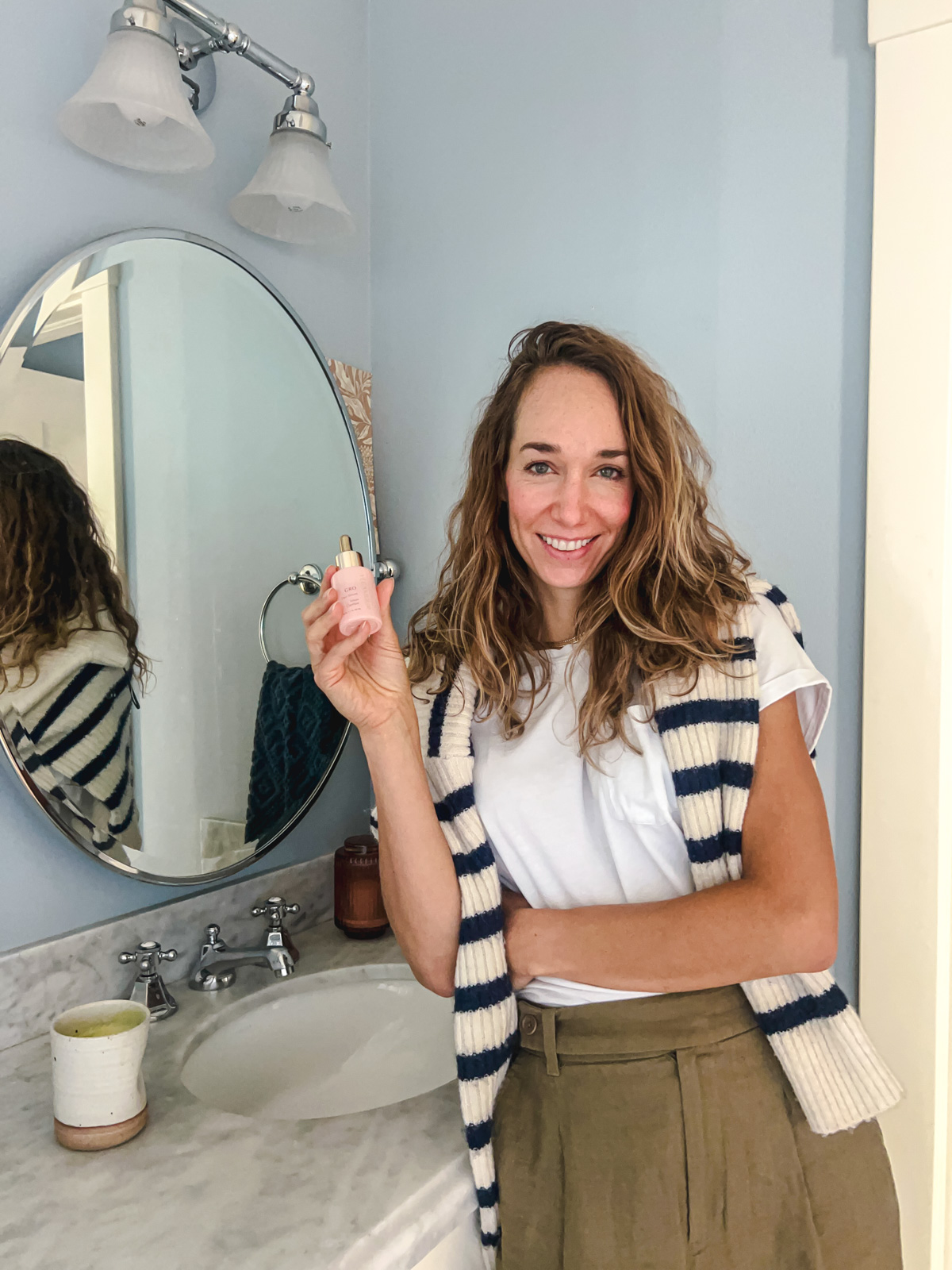New to meditation? These 7 effortless steps will help you start a mediation practice without the intimidation of not knowing what to do.

In our busy lives with jobs and kids and social events and commitments, it’s easy to get caught up in it all and feel frazzled and fried. One thing that has majorly helped reset my nervous system and start my days on a more calm note is my meditation practice.
If you’re new to meditation, it can feel intimidating at first—I get it, I felt the same way. There’s the fear of not knowing what you’re doing or worrying that you’re doing it wrong.
But, the truth is that meditating is actually really simple. And, that’s what makes it challenging. Calming your mind, noticing and letting go of random thoughts to instead focus on your breathing is truly a practice. It’s one that can bring you a sense of calm and ease in any situation and help ease anxiety over time.
As a working mom, my days can get crazy and having this grounding practice helps me to start my day with gratitude and calm, which is essential for my peace.
Whether you want to meditate to relieve stress, find more calm, gain focus and clarity or just to get more in touch with yourself, these 7 simple steps to meditate for beginners will give you the confidence to finally try it out.
It walks you through the best app for guided meditations and how to get started without feeling intimidated. Get ready to feel calm and empowered!
7 Effortless Steps to Start a Meditation Practice, Perfect for Total Beginners
1. Equipment for Meditation for Beginners
Good news—you don’t need any fancy equipment for meditation. You can use your phone and headphones if you plan on doing a guided meditation, but other than that, you don’t need a thing.
Sure, there are candles, meditation pillows, incense, essential oils and more that can deepen your practice, but none of them are necessary or essential.
As you continue to practice, you may find that the addition of something like this helps you focus or create the right mood—if so, then add it! But know that you will still get all the benefits without the extra stuff.
2. Start with a 10 Minute Guided Meditation
The best way to get started with meditation is to start with a guided practice where someone walks you through the process. It allows you to stay focused on what you’re doing, instead of pausing and looking at piece of paper or article for what you’re supposed to do next.
Despite having a meditation practice for over a year, I still enjoy a guided meditation the most. I love the prompts that they give before we start meditating. It helps me to realize more areas in my life that I can soften into.
To start, I highly recommend the Headspace app. This is easily the best guided meditation app I’ve ever used and the one I recommend to all of my friends and family. I’ve been using this for years and it has been incredible for keeping me consistent with my practice.
3. Find a Quiet Place & Time
Part of starting any new routine is creating the habits around it. Just read ‘Atomic Habits‘ to better understand how we can create habits that stick within our life.
Find a place you want to meditate and a time. I have a cozy chair in my office that is now my meditation chair. I aim to meditate before my kids wake up as it really sets off my day on the right note and helps me to remain calm and patient with them.
You can pick anywhere that works for you, but I find that picking a spot and time of day makes it easy to commit to because it’s simply part of my day.
As you get more comfortale with mediating, you get better at blocking out the outside noise and even making it part of your mediation, but when you’re first getting started a quiet place is easier.
4. 5-10 Minutes a Day to Start
The amazing thing about meditation is that you don’t have to practice for long periods of time to get the benefits. You can easily start with 5 to 10 minutes a day and work up to longer periods if that feels right for you.
You don’t need to meditate 20 minutes to get the benefits of meditation, but if you want to, then go for it. It’s all about finding what works for you.
As a mom, 10-15 minutes is about as long as I can fit into my schedule, and those short few minutes make all the difference in the world. It’s honestly shocking to see how big of an impact just a few short minutes can have in my day.
Starting with shorter periods of time is a good way to get used to sitting quietly with yourself. If you’re not used to it, it can be a challenge to get started.
RELATED: 8 Simple Ways to Create Stress-Free Mornings with Kids
5. Journal After your Meditation
This isn’t required, but it’s something that can really deepen your practice quickly.
After your meditation, take a few minutes to free write in a meditation journal. This can be anything that comes to mind, a stream-of-conscious gratitude journal, or something more focused, like what you want to manifest.
There are no rules, so just do what feels good.
I often find that I have some breakthroughs during my meditation that I don’t fully realize until I start writing, which is why I love doing this. I get to the root of things I’ve been struggling with faster when I pair meditation with journaling.
6. Focus on Consistency
To really get something out of your meditation practice, consistency is key. Just like any healthy habit, when you do it regularly it becomes part of your routine and you start to see the benefits sooner.
Don’t worry if you miss a day here or there. For me, weekends are sometimes a challenge because my kids are home and like to burst into my room mid-meditation.
But, when you realize that even just 5 minutes makes such a big impact on your day, it comes easier to prioritize and stay consistent.
7. Don’t Worry About the Outcome
It’s easy to think you’re doing it “wrong” if you don’t feel anything different after, but that’s why they call it a meditation practice. The more you practice, the better you get at calming your mind and focusing on your breathe.
There are some days where I feel like I’m literally floating in my chair and other days where I can’t stop scratching my nose or thinking about what I’m going to cook for dinner.
The point is that even if you’ve been doing it for a while, it is always a practice and it’s totally normal.
Now there’s the question, is meditation good for you? Absolutely yes. It can help calm your nervous system, relieve stress and anxiety, and benefit for emotional well-being.
Remember, the goal of meditation is to not control how you feel or feel happy every moment, it’s to be more in touch with how you feel and help you to realize that your thoughts create our reality and that you are actually in control of these thoughts.
Does this mean you’ll never feel anger or sadness, of course not! These are totally normal human reactions. But it will help you to understand your mind and in time bring you more peace and contentment.
It’s a simple and totally free way to calm your mind, get to know yourself better and ease anxiety—what’s there to lose?
BTW, how to receive signs from the universe to know you’re on the right path, and 3 easy morning rituals for a better day.








You must be logged in to post a comment.